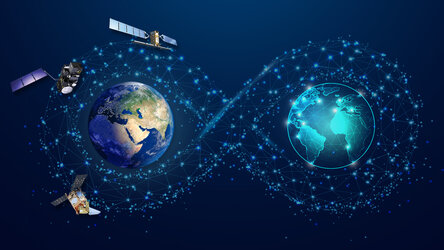AI in Earth observation: a force for good
The upcoming launch of the Φsat-2 mission is a prime example of the pioneering work that ESA does in the field of AI in Earth observation.
But when it comes to AI, hopes and fears abound in equal measure. In this interview, ESA’s Rochelle Schneider sets the record straight on how this transformational technology is improving access to crucial information on the state and future of our planet.
The success of generative AI tools like ChatGPT has brought with it new questions of what awaits us if the power and capabilities of AI continue to grow.
Fortunately, conferences such as AI For Good, in which ESA often participates, demonstrate that rather than causing harm, AI has a highly positive impact on society and sustainable development.
As an expert in machine learning, ESA Φ-lab AI Applications Lead Rochelle Schneider is well placed to explain why AI is a force for good in Earth observation. Rochelle has extensive experience in retrieving vital information from Earth observation data for the benefit of disease prevention and child development.
Rochelle, how would you define the role of AI in society?
AI leverages computers and machines to work for us in doing highly repetitive tasks or functions that can be automated. This allows us to work more efficiently and concentrate on those activities that require unreplaceable human roles, such as emotional intelligence, human relationships and intuition.
What’s your view of the idea that AI will result in a loss of jobs?
Well, AI will undoubtedly transform society, but this will create untold opportunities for new careers. We should look at AI therefore as a tool to facilitate or enhance human abilities and tasks, rather than something that will replace us in the job market.
We have to encourage the next generation of professionals to embrace the benefits of working with AI technologies. In Earth observation at ESA for example, we’re teaching young scientists and engineers to adopt the tools of machine learning as part of their understanding of data and data processing.
Can you explain how AI advances Earth observation?
Earth observation is being helped enormously by AI. Several satellites now have AI computers onboard for filtering and processing data, and downstream there are many applications that use AI to create critical insight for end users.
Computer vision amply illustrates the contribution AI makes. We extract many features from satellite images, like vegetation or coalmines, and although computers have been doing this for some time, they traditionally use fixed algorithms or models to spot the required objects.
With AI, the model keeps evolving and learning as new data arrive, and that’s a game changer in terms of our need for automatic detection. There are huge volumes of Earth observation data produced every day, and so automation from AI is a vital aid for monitoring Earth.
In the Child Connectivity project that ESA is carrying out with Giga for instance, we are assessing young people’s access to the internet. As part of this, we use AI algorithms to recognise school buildings from Copernicus Sentinel-2 data, and in Brazil alone we were able to identify 65 000 schools that were incorrectly located in the UNICEF database.
The area of prediction is also becoming increasingly important. In another major initiative with UNICEF, our climate-data AI models were able to forecast dengue fever outbreaks one month in advance.


Access the video
How does the rise of AI affect the commercial space sector?
There’s been an exponential growth in commercial Earth observation, and here too AI has a significant role. A large number of companies in Europe, many of them supported by the ESA InCubed programme, have sprung up in recent years.
These enterprises use AI-powered tailoring of satellite data for their customers, providing information in real time to government departments, disaster response agencies and industrial players like insurers.
The soon-to-be-launched Φsat-2 features onboard AI processing of the images from its multispectral camera. It already includes AI applications on the satellite that will eliminate clouds from its images, create street maps and detect shipping, but Φsat-2 also has the possibility for commercial companies to upload and run their applications in space.
We expect Φsat-2 and other satellites with onboard AI to generate a host of new business models and commercial opportunities, even for companies outside the space arena.
A final thought on AI: how do you see its contribution to Earth observation developing in the future?
I think in all walks of life we’re going to see AI coming together with many other emerging technologies. In Earth observation for instance, we’re currently working on Destination Earth, an AI-driven digital twin of the planet that will monitor the effects of natural and human activity and anticipate extreme events.
If we think about a further step, we can envisage a digital twin of Earth in the metaverse, an immersive experience delivering enhanced interactions and simulations via Extended Reality – a combination of Augmented and Virtual Reality.
More generally, AI tools will increasingly enter the mainstream of ESA’s operations and Earth observation activities, massively boosting our efforts towards a green and sustainable society by giving us more insightful information for decision making and the essential stewardship of the planet.














 Germany
Germany
 Austria
Austria
 Belgium
Belgium
 Denmark
Denmark
 Spain
Spain
 Estonia
Estonia
 Finland
Finland
 France
France
 Greece
Greece
 Hungary
Hungary
 Ireland
Ireland
 Italy
Italy
 Luxembourg
Luxembourg
 Norway
Norway
 The Netherlands
The Netherlands
 Poland
Poland
 Portugal
Portugal
 Czechia
Czechia
 Romania
Romania
 United Kingdom
United Kingdom
 Slovenia
Slovenia
 Sweden
Sweden
 Switzerland
Switzerland































